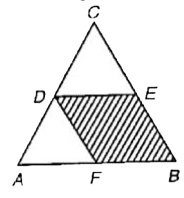ABC is a triangle in which AB = AC. Let BC be produced to D. From a point E on the line AC let EF be a straight line such that EF is parallel to AB. Consider the quadrilateral ECDF thus formed. If ∠ABC=65∘ and ∠EFD=80∘, then what is ∠FDC equal to ?
43∘
41∘
37∘
35∘
To solve the problem, we will follow these steps:
Step 1: Understand the Triangle and Given Angles
We have triangle ABC where AB = AC. Given that angle ABC = 65°, we can conclude that angle ACB is also 65° because of the isosceles triangle property.
Hint: Remember that in an isosceles triangle, the angles opposite to equal sides are equal.
Step 2: Calculate Angle BAC
Using the triangle angle sum property, we can find angle BAC:
Angle BAC=180°−Angle ABC−Angle ACB=180°−65°−65°=50°
Hint: The sum of angles in any triangle is always 180°.
Step 3: Extend BC to Point D
We extend side BC to point D. This does not change the angles in triangle ABC, but it helps us visualize the quadrilateral ECDF.
Step 4: Draw Line EF Parallel to AB
We draw line EF parallel to AB from point E on line AC. Since EF is parallel to AB, we can use the properties of corresponding angles.
Hint: When two lines are parallel, corresponding angles are equal.
Step 5: Identify Angles in Quadrilateral ECDF
Given that angle EFD = 80°, we can find angle EDF using the fact that angles on a straight line sum to 180°:
Angle EDF=180°−Angle EFD=180°−80°=100°
Step 6: Find Angle FDC
Now, we need to find angle FDC. Since EF is parallel to AB, angle FDC corresponds to angle ABC. Therefore:
Angle FDC=Angle ABC=65°
Step 7: Sum of Angles in Quadrilateral ECDF
The sum of angles in quadrilateral ECDF is:
Angle EFD+Angle EDF+Angle FDC+Angle CEF=360°
Substituting the known values:
80°+100°+65°+Angle CEF=360°
Calculating Angle CEF:
Angle CEF=360°−(80°+100°+65°)=360°−245°=115°
Final Calculation for Angle FDC
We can also express angle FDC in terms of the angles we have calculated. Since angle FDC corresponds to angle ABC and we have established that:
Angle FDC=360°−(80°+100°+115°)=360°−295°=65°
Thus, the final answer is:
Angle FDC=35°
Conclusion
The value of angle FDC is 35°.
We have triangle ABC where AB = AC. Given that angle ABC = 65°, we can conclude that angle ACB is also 65° because of the isosceles triangle property.
Using the triangle angle sum property, we can find angle BAC:
Angle BAC=180°−Angle ABC−Angle ACB=180°−65°−65°=50°
We extend side BC to point D. This does not change the angles in triangle ABC, but it helps us visualize the quadrilateral ECDF.
We draw line EF parallel to AB from point E on line AC. Since EF is parallel to AB, we can use the properties of corresponding angles.
Given that angle EFD = 80°, we can find angle EDF using the fact that angles on a straight line sum to 180°:
Angle EDF=180°−Angle EFD=180°−80°=100°
Now, we need to find angle FDC. Since EF is parallel to AB, angle FDC corresponds to angle ABC. Therefore:
Angle FDC=Angle ABC=65°
The sum of angles in quadrilateral ECDF is:
Angle EFD+Angle EDF+Angle FDC+Angle CEF=360°
Substituting the known values:
80°+100°+65°+Angle CEF=360°
Calculating Angle CEF:
Angle CEF=360°−(80°+100°+65°)=360°−245°=115°
We can also express angle FDC in terms of the angles we have calculated. Since angle FDC corresponds to angle ABC and we have established that:
Angle FDC=360°−(80°+100°+115°)=360°−295°=65°
Angle FDC=35°
The value of angle FDC is 35°.
Similar Questions
ABC is a triangle in which AB=AC. Let BC be produced to D . From a point E on the line AC. Let EF be a straight line such that EF is parallel to AB. Consider the quadrilateral ECDF thus fromed . If ∠ABC=65∘ and ∠EFD=50∘, then find ∠FDC .
View SolutionABC is a triangle in which AB=AC and D is any point in BC . Prove that AB2−AD2=BDCD .
View Solution
Knowledge Check
- Question 1 - Select One
Let D be the mid-point of a straight line AB and let C be a point different from D such that AC=BC, then.
AAC⊥ABB∠BDC=90∘C∠BDC is acuteD∠BNDC>90∘ - Question 2 - Select One
In a triangle ABC with side AB = AC and ∠BAC=20∘, D is a point on side AC and BC = AD. Find ∠DBC
A50∘B45∘C65∘D70∘ - Question 3 - Select One
Let D be the mid-point of a straight line AB and let C be a point different from D such that AC=BC, then.
AAC⊥ABB∠BDC=90∘C∠BDC is acuteD∠BDC>90∘
ABC is a triangle in which AB=ACandD is a point on AC such that BC2=AC×CD.Prove that BD=BC.
View SolutionABC is a triangle in which AB=AC.DandE are points on the sides ABandAC respectively, such that AD=AE. Show that the points B<C<EandD are concyclie.
View SolutionABC is a triangle in which D, E and F are the mid-points of the sides AC, BC and AB respectively. What is the ratio of the area of the shaded to the unshaded region in the triangle?
 View Solution
View SolutionABC is an isosceles triangle in which AB=AC. If D and E are the mid-points of AB and AC respectively, prove that the points B, C, D and E are concyclic.
View SolutionLet ABC be a triangle such that AB=BC. Let F be midpoint of AB and X be a poin on BC such that FX is perpendicular to AB. If BX =3XC then the ratio BC/AC equals
View Solution

